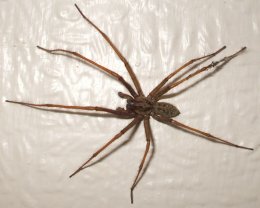Dave Farrance
2012-09-26 06:48:27 UTC
So this spider is on my lounge wall this morning.
Loading Image...
Just out of curiosity, I wondered which species it was, and I inferred
from Wikipedia that it's an ordinary Tegenaria Domestica?
http://en.wikipedia.org/wiki/Domestic_house_spider
However, the images on that page are a bit rubbish compared to the one
that I captured above with my £50 compact camera, so maybe I'll upload
mine to Wikipedia. Could somebody more knowledgeable tell me if I've
identified it correctly, and is it a male or a female, and how does one
tell, please?
Loading Image...
Just out of curiosity, I wondered which species it was, and I inferred
from Wikipedia that it's an ordinary Tegenaria Domestica?
http://en.wikipedia.org/wiki/Domestic_house_spider
However, the images on that page are a bit rubbish compared to the one
that I captured above with my £50 compact camera, so maybe I'll upload
mine to Wikipedia. Could somebody more knowledgeable tell me if I've
identified it correctly, and is it a male or a female, and how does one
tell, please?